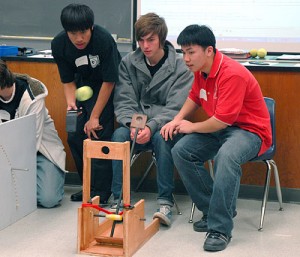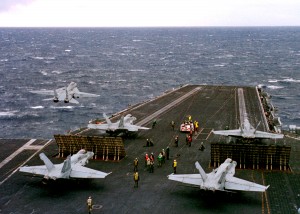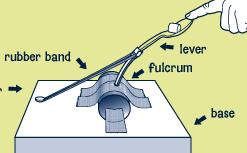Target Practice: Pumpkin Launcher
 Lesson from PBSKids.org Go FETCH! Click HERE for related PBS Learning Media STEM lesson plans and activities.
Lesson from PBSKids.org Go FETCH! Click HERE for related PBS Learning Media STEM lesson plans and activities.
Summary
In this activity, which can include discussions of simple machines and kinetic energy, teams of students in grades 1 to 6 follow the engineering design process to build and test a rubber band-powered catapult that launches marshmallow “pumpkins.” They then make changes to improve their launcher’s aim and distance it can hurl a projectile.
Grade level: 1 – 6
Time: 45 – 60 minutes (10 minutes prep time, 30 -45 minutes for the activity)
Standards
Next Generation Science Standard
Grade Level Disciplinary Core Ideas
- 3-5-ETS1.B.3 Tests are often designed to identify failure points or difficulties, which suggest the elements of the design that need to be improved.
- 3-5-ETS1.C.1 Different solutions need to be tested in order to determine which of them best solves the problem, given the criteria and the constraints.
- MS-ETS1.B.3 There are systematic processes for evaluating solutions with respect to how well they meet the criteria and constraints of a problem.
- MS-ETS1.C.3 Although one design may not perform the best across all tests, identifying the characteristics of the design that performed the best in each test can provide useful information for the redesign process—that is, some of those characteristics may be incorporated into the new design.
- 4-ETS1.B.2 Testing a solution involves investigating how well it performs under a range of likely conditions.
- 3-5-ETS1.B.1 Research on a problem should be carried out before beginning to design a solution. Testing a solution involves investigating how well it performs under a range of likely conditions.
- MS-ETS1.B.6 Models of all kinds are important for testing solutions.
- MS-ETS1.C.4 The iterative process of testing the most promising solutions and modifying what is proposed on the basis of the test results leads to greater refinement and ultimately to an optimal solution.
- MS-ETS1.B.4 Sometimes parts of different solutions can be combined to create a solution that is better than any of its predecessors.
- MS-PS3.A.2 A system of objects may also contain stored (potential) energy, depending on their relative positions.
- MS-PS3.A.1 Motion energy is properly called kinetic energy; it is proportional to the mass of the moving object and grows with the square of its speed.
- MS-PS3.A.5 The term “heat” as used in everyday language refers both to thermal energy (the motion of atoms or molecules within a substance) and the transfer of that thermal energy from one object to another. In science, heat is used only for this second meaning; it refers to the energy transferred due to the temperature difference between two objects.
- 4-PS3.A.1 The faster a given object is moving, the more energy it possesses.
- MS-ETS1.B.1 A solution needs to be tested, and then modified on the basis of the test results, in order to improve it.
- K-2-ETS1.C.1 Because there is always more than one possible solution to a problem, it is useful to compare and test designs.
Science & Engineering Practices Appendix F
- SEP.6.D Apply scientific ideas to solve design problems.
- SEP.2.C Develop a model using an analogy, example, or abstract representation to describe a scientific principle or design solution.
Engineering connection 
The catapult was used in ancient and medieval warfare to hurl stones and other projectiles at the enemy. Today, catapults are used for other purposes – like launching airplanes from aircraft carriers that have short runways. An aircraft catapult slings a plane forward, helping to create enough lift for a safe takeoff.
Many engineering schools mark Halloween by hosting pumpkin drops and pumpkin-launch competitions. Around the country, local contests have drawn second graders in Colorado as well as high school teams from New Jersey. The Mount Olive Robotics Team, for example, went all the way to the 2011 World Punkin Chuckin’ Championship. Read the Scientific American interview with the teacher and student team leader.
Engineering students vie in the University of Texas, San Antonio, Monster Mash Pumpkin Smash:
Materials
For each team:
- rubber band
- duct tape
- craft sticks

- brass fasteners
- mini marshmallows
- scissors
- pen
- toilet paper or paper towel tubes
- plastic spoon
- cardboard base (chipboard, shoebox, tissue box, cereal box, milk carton, etc.)
- target (trash bin, for example)
- meter stick (for extension activity)
Procedure
Build the launcher:
- Attach a toilet paper tube to a cardboard base. This is your fulcrum.
- Tape the handle of a plastic spoon to the end of a craft stick. This is your lever.
- Use a pen to make a hole in the top of the tube and insert the lever. Secure with tape.
- Punch a hole in the base in front of the tube (using the pen), and attach a brass fastener.
- Wrap a rubber band around the brass fastener, then around the middle of the lever (so that there is tension as you pull it back). Tape in place.
Launch it! Pull back on the lever and place a marshmallow in the spoon. Then, let go! What happened?
Design Your Own Now that you know how to build one kind of catapult, brainstorm your own design. Try a different base or fulcrum, build a different type of lever, or use the rubber band in a different way.
Test it! Can your marshmallow hit a target? How can you make it go farther? Or higher? Change one thing (a variable), like the length of the rubber band or the position of the lever. Predict what will happen. Then, test it!
Extensions
- Hold a Catapult Contest. See whose catapult can send the marshmallow the farthest. Use a meter stick to measure the distance, and then record the results.
- Older students can write down predictions, results, and conclusions in lab books, and share their redesigns with the class.
Additional resources:
Pumpkin launch device.Mount Olive (NJ) Robotics Team’s floating arm reverse trebuchet that competed in the 2011 World Punkin Chunkin’ Championship contest. Read the Scientific American interview with the teacher and student team leader.
FETCH! Target Practice Activity Sheet in English and Spanish.
FETCH! Challenge Pack. Hands-on engineering and science activities for 6- to 10-year-olds, plus tips for leading them, from PBSkids.org.
Simple Machines. TeachEngineering.org‘s teacher-tested lesson plan introducing the six simple machines, using examples such as the building of the pyramids and hands-on activities.
Minute Physics. Short videos explaining concepts from simple machines to dark energy.
Watch the University of Rochester engineering school”s annual pumpkin launch:
Lesson adapted from Target Practice! © 2014 WGBH Educational Foundation. All Rights Reserved.
Updated 10/23/19
Filed under: Class Activities, Grades 6-8, Grades K-5, Lesson Plans
Tags: catapult, Design, Elementary Education, Engineering Design, forces and motion, Halloween, levers, motions and forces, Physics, simple machines








